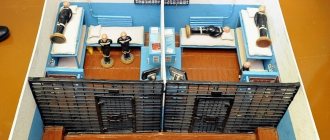What is it about, how did it glorify the prison, who is its author and why is it a great song in its own way?
Authors Mikhail Lurie, Nadezhda Rychkova
If you type the phrase “Vladimir Central” into a search engine, the prison and the song will always be connected in the results. The song is understandable, because its name refers to a very specific institution in Vladimir, but almost every material about it mentions a composition by Mikhail Krug. The question arises, who made whom famous: did the song glorify the Vladimir prison throughout Russia or did the pre-song fame of the Vladimir Central provide the song with such recognition?
Chicken Run
Mikhail Frunze.
wikipedia One of the legends about the Vladimir prison is associated with the name of the fiery revolutionary figure, creator of the Red Army, Mikhail Frunze It says that this violent prisoner managed to escape from prison.
In fact, no one managed to escape from the Vladimir Central, and Frunze is no exception. He actually sat here - for assaulting a policeman. If you believe Skobeinikov , Frunze’s cellmate, who later wrote a book, Mikhail Vasilyevich even bribed one of the guards to give the prisoner a sign: the time had come for an escape - but the guard, a big fan of giving in, drank too much and passed out at the most crucial moment. As for Frunze, he still escaped - but not from the Vladimir Central Prison, but from the courtroom.
Central for denied
Among the “brothers”, “Vladimir Central” has long been considered a semblance of a Muslim Mecca. Any prisoner who chose the path of “denial” considered it a duty or an honor to visit it. In Soviet times, the rules established in prison were not considered super harsh for hardened criminals, although the prison regime was officially in effect there. “Black Dolphin”, “White Swan”, “Polar Owl” and a dozen more numbered prisons and maximum security colonies in the Urals or Siberia imposed more severe demands on prisoners, being considered among them “breaking factories”.
Thief in law Vasily Buzulutsky
Among the famous inmates of the Vladimir Central are the legendary thieves in law Vasya Brilliant (Babushkin) and Vasya Buzulutsky. Vladimir Bukovsky met with Diamond while imprisoned in Vladimir and tried to find in him an ally in the struggle of dissidents. The attempt was unsuccessful.
Diamond was suspicious of the idea of introducing democratic freedoms into Russian life. After this meeting, a saying attributed to the most eminent “thief in law” remained in history that the “grey-legged”, as he called those convicted on political charges, have masters in the West and flirting with them could destroy the unity of the thieves.
Of the current characters in the modern world of thieves, the thieves' dynasty of the Asatryans, Edik Osetrina and Seryozha Bentley, visited the central in full force, although the latter was literally passing through.
Thieves in law Sergei and Eduard Asatryan
Geographically, the complex of buildings of the Vladimir Central, divided into buildings, occupies an entire block. At the same time, it can accommodate 1,220 prisoners, with about 900 people on a prison regime. For the last decades, a large prison administration has been commanded by an internal service officer with the rank of colonel. There is an industrial zone attached to the prison, where convicts who have entered the path of correction continue to be rehabilitated through labor.
Vladimirsky produces sports equipment ─ gymnastic mats, sawhorses, boxing gloves, punching bags and bags. The great age of the prison buildings and the architectural decisions made during construction do not allow us to hope that the Vladimir Central will ever achieve the conditions of detention accepted in civilized countries. In the meantime, the oldest building has undergone a major overhaul. Only in this one today the standard area per prisoner is maintained - 4 m² and a modern video surveillance system is used to monitor the situation in the cells and corridors.
Gldani Prison No. 8, Tbilisi
Georgia, for example, closed all the old Soviet prisons and completely rebuilt new ones according to modern designs. Huge Russia probably cannot afford this, but the central building would make a good museum, where every extreme sports enthusiast could plunge into the eerie atmosphere of the place of suffering of tens of thousands of people and briefly imagine himself in their place.
Felt boots and felt boots...
wikipedia Everyone’s favorite performer of Russian songs, the inimitable Lydia Ruslanova, also did not escape the Vladimir prison. She was imprisoned because of her husband, General Vladimir Kryukov , who was friends with Georgy Zhukov : Stalin was frightened by the growing authority of the victorious military leaders after the war, and he tried to remove many of them.
Lydia was taken during her own concert and imprisoned as a member of an anti-Soviet group that does not exist in reality. The selfish singer, who had been saving money, clothes and jewelry for a long time, brought with her to prison seven suitcases filled with clothes and shoes. She behaved defiantly, and every now and then she ended up in a punishment cell. According to some rumors, she constantly sang in her cell; according to others, she quickly lost her voice and, upon leaving prison, did not immediately regain it.
The price of loving an American
Zoya Fedorova.
wikipedia Actress Zoya Fedorova spent some time in the same cell with Ruslanova. Unlike her wealthy neighbor, she had almost no property - she was taken to prison in only a padded jacket.
This young beautiful and by that time already famous film actress went to prison because she fell in love with the wrong person - American officer Jackson Tate . They even had a child together - a girl, Vika , who later became an actress and writer Victoria Fedorova .
However, Tate was expelled from the country even before the birth of his daughter, and Zoya was arrested in 1946, separated from her child, on charges of espionage, she was mocked for a long time and sentenced to 25 years in prison. Fortunately, she did not serve the entire sentence - she was released in 1955.
"Vladimir Central": famous inmates of a strict prison
The best illustration of the proverb “Don’t swear off prison or bag” was in the last century by the inhabitants of the most famous prison in Russia, Vladimir Central. Among its prisoners were especially dangerous criminals, prominent political figures and their relatives, dissidents, foreign spies, Nazis, people’s favorite representatives of the arts - from writers to the most beautiful actresses. Over the more than two centuries of its existence, the Vladimir Central has become a legend - and the dark spots in its history can be investigated endlessly.
On the way to hard labor
Wikimedia Vladimir prison for especially dangerous criminals was founded in 1783 by personal order of Catherine II . The transit point was located right on the Vladimirsky tract or, as it was called then, Vladimirka.
In pre-revolutionary Russia, convicts were driven along this road into Siberian exile and to Sakhalin. The condemned walked in groups of several hundred people. The unfortunate ones had to travel the entire route on foot, regardless of the time of year, so the journey took from two to three years. Later, with the invention of the steam locomotive, the road became empty.
At the beginning of the twentieth century, when after the first revolution the flow of convicts increased significantly, the Vladimir prison became central in the country - and received the name central. It lost its special status only in the late 1970s, turning into a men's prison for especially dangerous criminals.
One of the first famous “visitors” of the legendary central was the famous commander of the Civil War, Mikhail Frunze , who remained in the annals of the prison also thanks to the first and last escape in its history.
Famous and not so famous
Times have changed, and the oppressed are themselves oppressors. With the arrival of the Bolsheviks, the Vladimir Central became a special State Security prison, turning into an isolation ward for anti-Soviet activists. The Kronstadt sailors who rebelled against the communists were the first to end up in the central.
During the years of Stalinist repression, the ranks of guests were joined by prominent scientists, writers and dissidents. Many of its prisoners were kept secret; the names of some of them still cannot be found out. But it is known that relatives of Stalin - the sister of his wife Nadezhda and even his son Vasily .
Vasily Stalin in the cockpit of an airplane, 1943. Wikimedia
Like all famous prisoners of the prison, Vasily Iosifovich Stalin was listed under a number in the documents, and his name was not known at first. The disgraced son of the “leader of the peoples” turned out to be an excellent turner who designed a cart that reliably served for transporting food for more than 50 years.
By the way, the first prisoners in the USSR to start working in production were the residents of the central prison. Radio components were produced outside the prison walls. Now the production has survived and is trying to compete with the Chinese in the production of sports equipment.
Writer Daniil Andreev. Flickr.com
In the same years as Vasily Stalin, according to the old Russian tradition, people who doubted the existing system also ended up in the famous prison. In the 50s of the last century, the writer Daniil Andreev , where he created the main work of his life, “The Rose of the World.”
His cellmates were the prominent physiologist Vasily Parin and the Soviet historian Lev Rakov . Now there is an Orthodox church in this cell. Next door to them lived in a tiny cell a staunch monarchist and anti-Semite, writer Vasily Shulgin .
In the next decade, the central, in turn, opened its doors to everyone whom Shulgin disliked so much. These were dissidents Yuli Daniel , Vladimir Bukovsky and even Natan Sharansky , who later became a prominent Israeli statesman.
Soviet prison glamor
The walls of the Vladimir Central saw not only extraordinary men, but also ladies from Soviet bohemia. The first such “guest”, or rather a house sitter, was the wife of Army Commander Budyonny, singer Olga Mikhailova . Arrested right during the concert, allegedly for having connections with foreigners, the Bolshoi Theater artist spent a total of almost 20 years in prison and exile.
Zoya Fedorova after a front-line concert, 1943. Wikimedia
Zoya Fedorova , who loved spending time in the American military mission, did not escape this fate Even the birth of a daughter from an American officer did not save her from the Vladimir Central.
The story of why Fedorov served her sentence is quite complicated, just like the sensational murder of the actress 40 years later. But the time after leaving prison before her death was not in vain for her - she starred in more than 30 films.
It is believed that the directors were ordered from above to invite her to filming as actively as possible - thus the actress was “paid” for silence. There is a version that in fact Fedorova was recruited by the authorities - and her affair with Jackson Tate was also initiated by them.
According to rumors, Zoya Fedorova’s cellmate was the legendary singer Lidiya Ruslanova . Being married to General Kryukov , a comrade-in-arms of Marshal Zhukov , the singer found herself in the millstone of regular repressions and behind-the-scenes political fuss.
In a poor country, the luxury of many high-ranking leaders was provocative. Four trophy cars, dozens of antiques and about a hundred paintings by famous artists were confiscated from the Ruslanova family. The family also loved expensive furniture, furs and fabrics taken from defeated Germany. During the search, about two hundred diamonds and a million Soviet rubles were found.
Singer Lydia Ruslanova and Soviet soldiers at the walls of the Reichstag, May 1945. Wikimedia
In the camp, Lydia Ruslanova spoke to prisoners and management, but this did not last long. In the spring of 1950, the singer was transferred to the Vladimir Central, where she remained until Stalin’s death. According to rumors, the legendary performer loved to sing behind prison bars, for which she was sent to punishment cell more than once.
North wind...
It’s not only Lydia Ruslanova who connects the Vladimir prison with the world of music. The deceased singer Mikhail Krug wrote a song about the central prison that made the prison famous throughout the country. It is believed that it is dedicated to the famous authority Alexander Severov , known under the nickname “North”, who was born in the zone and served a total of 20 years in prison. This multifaceted man, having spent most of his life in prison, was well versed in all the intricacies of show business and, according to rumors, was personally the author of several songs by Mikhail Krug.
Mikhail Krug, 2008. globallookpress.com
They say that the song, which became Krug’s main hit, was written by him after he was in prison on a date with Sever, who was his friend. There is a version that the chansonnier originally wrote a different chorus - with the words “Vladimir Central, Sasha Severny , on the stage from Tver...”. But he asked to remove his name from the song.
"Rose of the World"
This philosophical work was conceived and started by Daniil Andreev precisely within the walls of the Vladimir Central. The writer was arrested in 1947. He was accused of agitation against the existing government, of creating an anti-Soviet group - and even of an attempt on the life of the leader of all times and peoples.
Daniil Andreev. wikipedia
The proof of Andreev’s guilt in all these terrible crimes was... his novel “Wanderers of the Night.” The novel was solemnly burned as soon as the investigation was over, and the writer was given 25 years in prison. In prison, fortunately, he was allowed to write.
In 1954, the term was reduced to 10 years, and in 1957 Andreev was released - but after that he lived only two years: imprisonment undermined his health. He died in Moscow in 1959.
Central Prison
It received the historical name “Vladimir Central” only in 1906. Central means central prison. Most of the names were given to it under the Bolsheviks. They did not destroy it, like the rebel revolutionary French did the Bastille. Central fit perfectly into the Soviet regime. In 1921, it received the name “Provincial Isolator for Special Purposes,” emphasizing its punitive role against political opponents.
Vladimir Central: facade overlooking Bolshaya Nizhegorodskaya
In February 1948, a resolution of the Council of Ministers of the USSR put everything in its place without omissions. “Vladimir Central” was included in the system of special camps and prisons, which were ordered to contain especially dangerous state criminals, spies, saboteurs, terrorists, Trotskyists, Mensheviks, Socialist Revolutionaries, anarchists, nationalists and white emigrants.
Prison buildings and paddy wagon
By that time, more than 30 years had passed since the revolution, half of which was under conditions of total terror, but, as it turned out, not all “enemies of the people” had turned into “camp dust.” The year 1937 clearly could not ignore the Vladimir Central, but the details of the events that took place within its walls were completely lost. There were no people or documents left. When the Germans approached Moscow in 1941, the prison was actively preparing for evacuation to Ivanovo. The archives were destroyed in a terrible hurry.
Vladimir Central: side view
The Germans still got into the central area. A group of captured German generals was sent there, whose release was negotiated by the first Chancellor of the Federal Republic of Germany, Adenauer. The Japanese prisoners were less fortunate. The generals of the Kwantung Army who found themselves in Vladimir all died out, unable to withstand the unusual climate and food. None of them returned to their homeland, and the bodies of the dead were buried in a cemetery located next to the prison.
His father's son
wikipedia In January 1956, a strange prisoner was brought to the famous prison. He did not have a number, like the rest of the prisoners; he was listed in the documents as Vasily Pavlovich Vasiliev .
It was ordered to prepare a cell for him in advance, so that it looked like a modest hotel room, and not a separate room in a dungeon: with a radio point, with fresh flowers in a vase. The guards were strictly forbidden to enter into conversations with the mysterious prisoner. He himself did not seek to communicate with anyone. However, he behaved roughly and did not violate the rules; He worked as a mechanic in a farm yard, even with his own hands he designed a very convenient cart for transporting food.
Only a few months after Vasilyev’s arrival at the prison, the guards learned that their ward was the son of the late leader Vasily Stalin.
Boyko Anna
Interesting story prison










